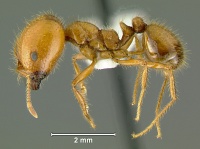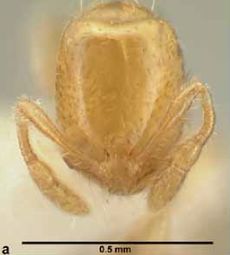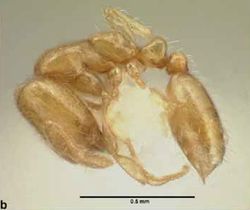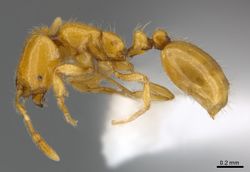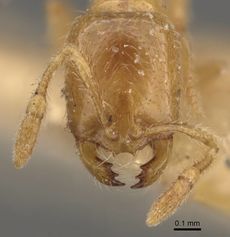Key to Arabian Solenopsis
This worker key is based on: Sharaf, M.R. and Aldawood, A.S. 2012. Ants of the genus Solenopsis Westwood 1840 in the Arabian Peninsula with description of a new species, Solenopsis elhawagryi. PloS ONE. 7(11):21 pp. doi:10.1371/journal.pone.0049485
You may also be interested in
Little is known about habitat and biology of Palaearctic and Arabian Solenopsis. Workers seem to build nests in the ground, sand mounds, and litter. Some nest under stones, e g. S. sumara, S. dentata and S. elhawagryi. Or such as S. cooperi on Saloga and Ghazal islands in Nile River (Aswan, Egypt), nest in loose sandy soil close to bases of dead trees. Solenopsis saudiensis nests under date palms, among decaying dropped fruit, directly under rocks or even inside discarded carpet. The latter species often coexists with Tapinoma simrothi Krausse that attends mealybugs. Solenopis geminata is known to nest in open sunny areas of disturbed agricultural landscapes and around buildings, where nest mounds are defended aggressively by workers.
It appears that the Solenopsis in the Arabia is restricted to mid and lower elevations, usually below ca. 600 m. Despite repeated ant collections, there are only two records from the mountainous regions of southwestern Saudi Arabia and nearby Yemen. S. sumara has been reported from Yemen, at 2500 m and, here, we report the new species S. elhawagryi. In Egypt, no Solenopsis were found in over 25 field trips to the high mountains of Sinai.
1
- Posterior margin of head in majors deeply emarginated with strongly convex temples and with a median furrow extending forward to frons; propodeal dorsum of large and smaller workers with distinct dorsolateral carinae (Pantropical species) . . . . . Solenopsis geminata
 Solenopsis geminata, Major |
- Posterior margin of head straight or feebly concave but not deeply emarginated nor with median furrow; propodeal dorsum of large and smaller workers without carinae of any type . . . . . 2
2
return to couplet #1
- Eyes with a single ommatidium . . . . . 3
- Eyes with more than one ommatidium . . . . . 5
3
return to couplet #2
- Head in lateral view with flat dorsal and ventral surfaces; head in full-face view with nearly parallel sides; propodeum profile distinctly angled at junction of dorsum and declivity (Egypt) . . . . . Solenopsis cooperi
- Head in lateral view with convex dorsal and ventral surfaces; head in full-face view with sides nearly parallel or shallowly convex; propodeum profile with a smoothly rounded transition from dorsum to declivity . . . . . 4
4
return to couplet #3
- TL 1.30–1.71; head in full-face view with clearly parallel sides; eyes large; eye length 0.1 times head width or more; first gastral tergite dark brown; EL 0.04–0.05 (Egypt) . . . . . Solenopsis occipitalis
- TL 2.0; head in full-face view with shallowly convex sides with rounded posterior corners; eyes smaller, eye length 0.04 times head width; whole gaster unicolorus yellow; EL 0.02 (Egypt) . . . . . Solenopsis kochi
5
return to couplet #2
- Postpetiole with a distinct anteroventral flange seen in profile as a tooth-like projection . . . . . 6
- Postpetiole without a distinct anteroventral projection . . . . . 7
6
return to couplet #5
- Head in lateral view appears narrow with a flat ventral surface; unicolorous yellow, cephalic dorsum and first gastral tergite yellow with brownish tint; eyes with seven ommatidia (Oman and United Arab Emirates) . . . . . Solenopsis omana
- Head in lateral view appears thick with a flat dorsal surface and a distinctly convex ventral surface; head of major workers brownish yellow; eyes with 4–5 ommatidia (Saudi Arabia) . . . . . Solenopsis elhawagryi
7
return to couplet #5
- Eyes with nine facets, the outer circle of facets enclosing a single relatively large facet (Egypt) . . . . . Solenopsis lou
- Eyes with 2–4 facets . . . . . 8
8
return to couplet #7
- Head rather square, only slightly longer than wide; eyes with only 3–4 ommatidia; in large workers, head with six strong frontal striae on the frons (Yemen) . . . . . Solenopsis zingibara
- Head subrectangular; eyes with only two ommatidia; head normal, without the above mentioned six striae . . . . . 9
9
return to couplet #8
- Large dimorphic yellowish brown species, TL 1.50–2.48; head much broader HW 0.36–0.55 and much longer HL 0.44–0.68; propodeal dorsum a gradual flat slope which is slightly longer than declivity; petiole distinctly broader than long in dorsal view; petiole in profile with a massive and high rounded node; area between frontal carinae finely longitudinally striated (Yemen) . . . . . Solenopsis sumara
- Smaller, monomorphic yellowish species, TL 1.2–1.3; head narrower HW 0.30–0.31 and shorter HL 0.31–0.41; propodeal dorsum making a continuous angle with the declivity, no distinction of propodeal angle; petiole as long as broad in dorsal view; petiolar node high and slightly pointed in lateral view; area between frontal carinae smooth (Saudi Arabia) . . . . . Solenopsis abdita (as Solenopsis saudiensis)
